Each asset class has its own risk and return characteristics. The level of risk associated with a particular investment or asset class generally correlates with the level of return the investment or asset class might achieve. Stock markets, especially foreign markets, are volatile. Stock values may fluctuate in response to general economic and market conditions, the prospects of individual companies, and industry sectors. Foreign investing has additional risks including those associated with currency fluctuation, political and economic instability, and different accounting standards. These risks are heightened in emerging markets. Small- and mid-cap stocks are generally more volatile, subject to greater risks and are less liquid than large company stocks. Bonds are subject to market, interest rate, price, credit/default, liquidity, inflation and other risks. Prices tend to be inversely affected by changes in interest rates. High yield (junk) bonds have lower credit ratings and are subject to greater risk of default and greater principal risk. The commodities markets are considered speculative, carry substantial risks, and have experienced periods of extreme volatility. Investing in a volatile and uncertain commodities market may cause a portfolio to rapidly increase or decrease in value which may result in greater share price volatility. Real estate has special risks including the possible illiquidity of underlying properties, credit risk, interest rate fluctuations and the impact of varied economic conditions.
Alternative investments, such as hedge funds, private equity/private debt and private real estate funds, are speculative and involve a high degree of risk that is appropriate only for those investors who have the financial sophistication and expertise to evaluate the merits and risks of an investment in a fund and for which the fund does not represent a complete investment program. They entail significant risks that can include losses due to leveraging or other speculative investment practices, lack of liquidity, volatility of returns, restrictions on transferring interests in a fund, potential lack of diversification, absence and/or delay of information regarding valuations and pricing, complex tax structures and delays in tax reporting, less regulation and higher fees than mutual funds. Hedge fund, private equity, private debt and private real estate fund investing involves other material risks including capital loss and the loss of the entire amount invested. A fund's offering documents should be carefully reviewed prior to investing.
Hedge fund strategies, such as Equity Hedge, Event Driven, Macro and Relative Value, may expose investors to the risks associated with the use of short selling, leverage, derivatives and arbitrage methodologies. Short sales involve leverage and theoretically unlimited loss potential since the market price of securities sold short may continuously increase. The use of leverage in a portfolio varies by strategy. Leverage can significantly increase return potential but create greater risk of loss. Derivatives generally have implied leverage which can magnify volatility and may entail other risks such as market, interest rate, credit, counterparty and management risks. Arbitrage strategies expose a fund to the risk that the anticipated arbitrage opportunities will not develop as anticipated, resulting in potentially reduced returns or losses to the fund.
Bloomberg U.S. Aggregate 1-3 Year Bond Index is composed of the Bloomberg U.S. Government/Credit Index and the Bloomberg U.S. Mortgage-Backed Securities Index, and includes Treasury issues, agency issues, corporate bond issues, and mortgage-backed securities with maturities of 1-3 years.
Bloomberg U.S. Aggregate 5-7 Year Bond Index is composed of the Bloomberg U.S. Government/Credit Index and the Bloomberg U.S. Mortgage-Backed Securities Index, and includes Treasury issues, agency issues, corporate bond issues, and mortgage-backed securities with maturities of 5-7 years.
Bloomberg U.S. Aggregate 10+ Year Bond Index is composed of the Bloomberg U.S. Government/Credit Index and the Bloomberg U.S. Mortgage-Backed Securities Index, and includes Treasury issues, agency issues, corporate bond issues, and mortgage-backed securities with maturities of 10 years or more.
Bloomberg U.S. Corporate Bond Index includes publicly issued U.S. corporate and Yankee debentures and secured notes that meet specified maturity, liquidity, and quality requirements.
Bloomberg U.S. Corporate High Yield Index covers the universe of fixed-rate, noninvestment-grade debt.
Bloomberg U.S. Corporate High Yield Bond OAS Index measures the Option adjusted spreads of USD-denominated, high yield, fixed-rate corporate bond market. Securities are classified as high yield if the middle rating of Moody's, Fitch and S&P is Ba1/BB+/BB+ or below.
MSCI EAFE Index is designed to represent the performance of large and mid-cap securities across 21 developed markets, including countries in Europe, Australasia and the Far East, excluding the U.S. and Canada.
MSCI Emerging Markets Index is a free float-adjusted market capitalization index that is designed to measure equity market performance of emerging markets.
Russell 1000® Index measures the performance of the 1,000 largest companies in the Russell 3000 Index, which represents approximately 90% of the total market capitalization of the Russell 3000 Index.
Russell 2000® Index measures the performance of the 2,000 smallest companies in the Russell 3000® Index, which represents approximately 8% of the total market capitalization of the Russell 3000 Index.
Russell 3000® Index measures the performance of the 3,000 largest U.S. companies based on total market capitalization, which represents approximately 98% of the investable U.S. equity market.
Russell Midcap® Index measures the performance of the 800 smallest companies in the Russell 1000 Index.
S&P 500 Index is a market capitalization-weighted index composed of 500 widely held common stocks that is generally considered representative of the US stock market.
An index is unmanaged and not available for direct investment.
Global Investment Strategy (GIS) is a division of Wells Fargo Investment Institute, Inc. (WFII). WFII is a registered investment adviser and wholly owned subsidiary of Wells Fargo Bank, N.A., a bank affiliate of Wells Fargo & Company.
The information in this report was prepared by Global Investment Strategy. Opinions represent GIS’ opinion as of the date of this report and are for general information purposes only and are not intended to predict or guarantee the future performance of any individual security, market sector or the markets generally. GIS does not undertake to advise you of any change in its opinions or the information contained in this report. Wells Fargo & Company affiliates may issue reports or have opinions that are inconsistent with, and reach different conclusions from, this report.
The information contained herein constitutes general information and is not directed to, designed for, or individually tailored to, any particular investor or potential investor. This report is not intended to be a client-specific suitability or best interest analysis or recommendation, an offer to participate in any investment, or a recommendation to buy, hold or sell securities. Do not use this report as the sole basis for investment decisions. Do not select an asset class or investment product based on performance alone. Consider all relevant information, including your existing portfolio, investment objectives, risk tolerance, liquidity needs and investment time horizon. The material contained herein has been prepared from sources and data we believe to be reliable but we make no guarantee to its accuracy or completeness.
Wells Fargo Advisors is registered with the U.S. Securities and Exchange Commission and the Financial Industry Regulatory Authority, but is not licensed or registered with any financial services regulatory authority outside of the U.S. Non-U.S. residents who maintain U.S.-based financial services account(s) with Wells Fargo Advisors may not be afforded certain protections conferred by legislation and regulations in their country of residence in respect of any investments, investment transactions or communications made with Wells Fargo Advisors.
Wells Fargo Advisors is a trade name used by Wells Fargo Clearing Services, LLC and Wells Fargo Advisors Financial Network, LLC, Members SIPC, separate registered broker-dealers and non-bank affiliates of Wells Fargo & Company.



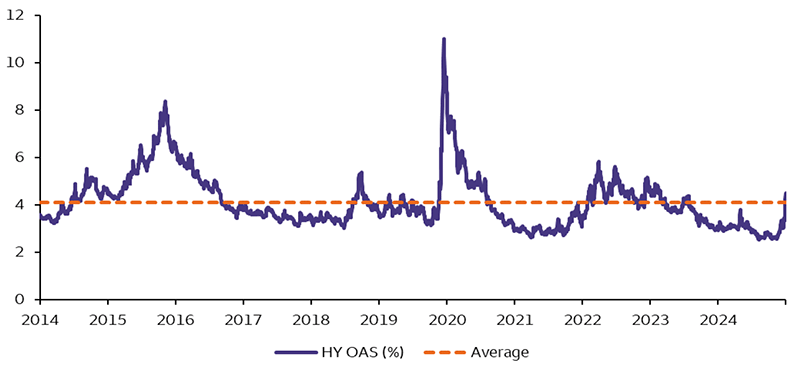 Sources: Bloomberg and Wells Fargo Investment Institute as of April 7, 2025. Measured by the Bloomberg U.S. Corporate High Yield Bond OAS Index. Past performance is no guarantee of future results. An index is unmanaged and not available for direct investment.
Sources: Bloomberg and Wells Fargo Investment Institute as of April 7, 2025. Measured by the Bloomberg U.S. Corporate High Yield Bond OAS Index. Past performance is no guarantee of future results. An index is unmanaged and not available for direct investment.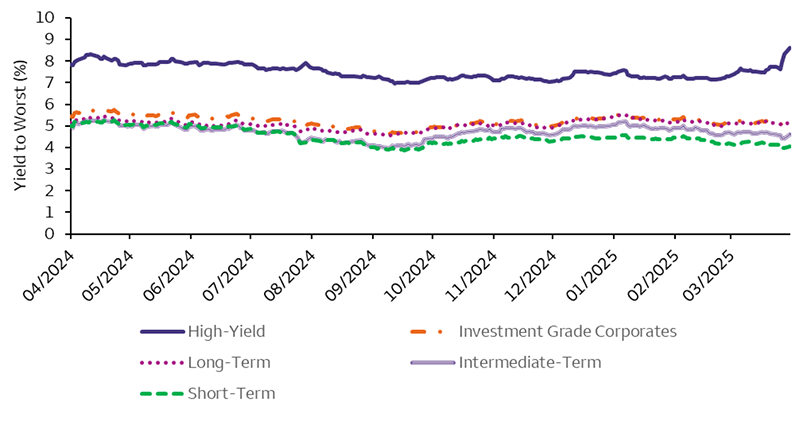 Sources: Bloomberg and Wells Fargo Investment Institute as of April 7, 2025. Measured by yield to worst. High yield represented by the Bloomberg U.S. Corporate High Yield Index. Investment-grade corporates represented by the Bloomberg U.S. Corporate Index. Short-term represented by the Bloomberg U.S. Aggregate 1 – 3 Year Index. Intermediate term represented by the Bloomberg U.S. Aggregate 5 – 7 Year Index. Long-Term represented by the Bloomberg U.S. Aggregate 10+ Year Index. Past performance is no guarantee of future results. An index is unmanaged and not available for direct investment.
Sources: Bloomberg and Wells Fargo Investment Institute as of April 7, 2025. Measured by yield to worst. High yield represented by the Bloomberg U.S. Corporate High Yield Index. Investment-grade corporates represented by the Bloomberg U.S. Corporate Index. Short-term represented by the Bloomberg U.S. Aggregate 1 – 3 Year Index. Intermediate term represented by the Bloomberg U.S. Aggregate 5 – 7 Year Index. Long-Term represented by the Bloomberg U.S. Aggregate 10+ Year Index. Past performance is no guarantee of future results. An index is unmanaged and not available for direct investment.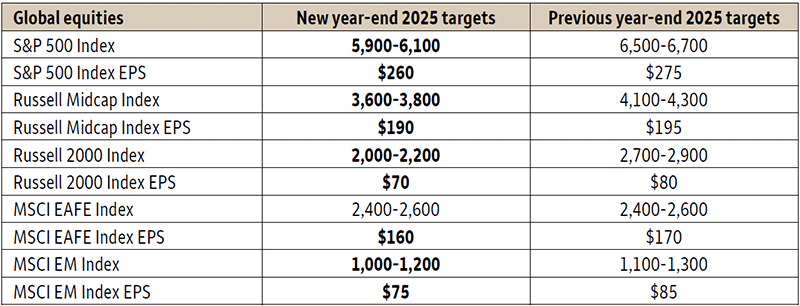
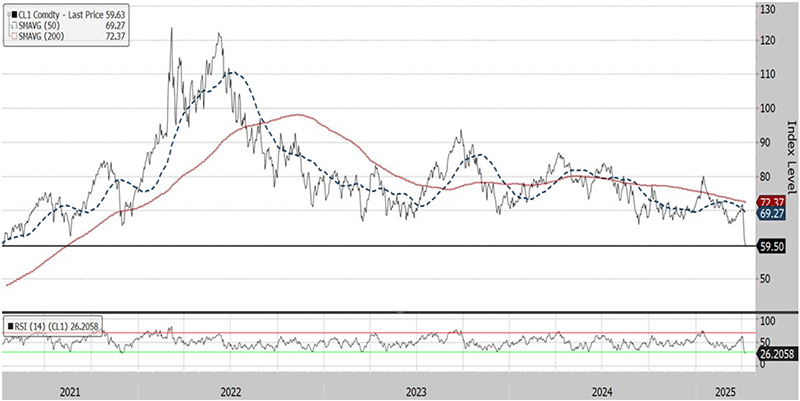 Sources: Bloomberg and Wells Fargo Investment Institute. Daily data from April 8, 2021, through April 8, 2025. CL1 = Generic 1st WTI futures contract. SMAVG (50) = 50-day simple moving average. SMAVG (200) = 200-day simple moving average. RSI = relative strength index. Past performance is no guarantee of future results. An index is unmanaged and not available for direct investment.
Sources: Bloomberg and Wells Fargo Investment Institute. Daily data from April 8, 2021, through April 8, 2025. CL1 = Generic 1st WTI futures contract. SMAVG (50) = 50-day simple moving average. SMAVG (200) = 200-day simple moving average. RSI = relative strength index. Past performance is no guarantee of future results. An index is unmanaged and not available for direct investment.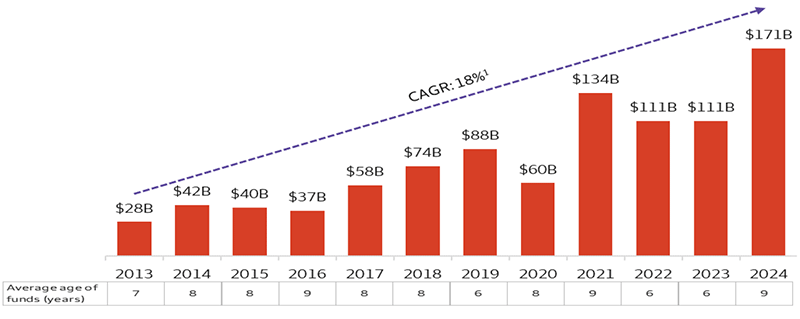 Sources: Greenhill Advisory and Wells Fargo Investment Institute. Data as of December 31, 2024. 1 Simple average of all funds in Greenhill sample set of closed transactions.
Sources: Greenhill Advisory and Wells Fargo Investment Institute. Data as of December 31, 2024. 1 Simple average of all funds in Greenhill sample set of closed transactions.